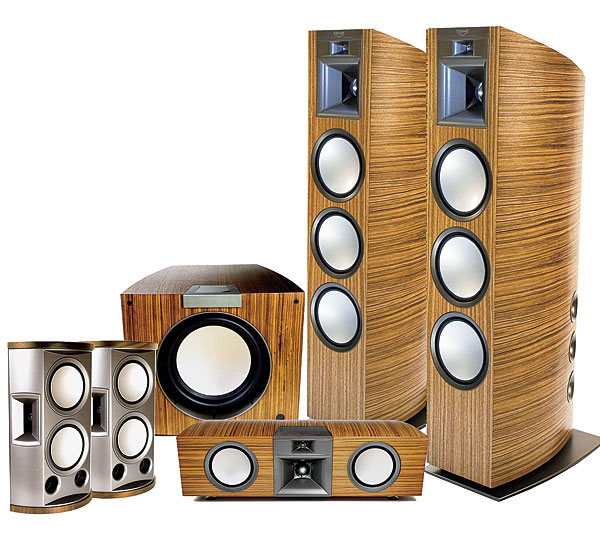How to Choose a Home Theater for Movies or Music Page 2
Balancing Your Speaker Budget
Not surprisingly, your selection of speakers is perhaps the most critical factor in leaning your system more toward music or home theater playback. Definitive Technology’s senior vice president Paul DiComo told me that, according to his customer surveys, “Even when people say they’re going to be watching movies 80 percent of the time, they really care about how the system sounds with music.” I took that as a given, but unless you have the very best speakers, there are inevitable trade-offs. Tonal balance issues and flat frequency response are generally more relevant performance concerns for music-oriented listeners.

If you’re primarily using your home theater for movies, consider putting more money into a better center-channel speaker, though always one that’s timbre-matched to the rest of your speakers. If music is the mainstay, put the majority of your speaker budget into the front left and right speakers. And, if you only watch an occasional movie, you might even consider forgoing the sub and using full-range tower speakers.
Once you’ve identified what you want, don’t make the mistake of buying by brand alone. Sometimes, we have a tendency, fair or not, to associate specific brands more with movies or music. But model selection is the key, even within a company’s offerings.
Here’s a hypothetical systemmatching exercise, starting with a music-oriented Definitive Technology system. For this, I’d go with their BP-8080ST towers ($1,499 each), which have built-in subwoofers; one of their smaller matching centers, the CS-8040HD ($499); and a pair of ProMonitor 800 surround speakers ($145 each). For a more theater-oriented system with close to the same list price, I’d use much smaller towers, the BP-8020STs ($599 each); the CS-8060HD center speaker with built-in sub ($699); SR-8080BP surround speakers ($349 each); and a SuperCube 1 subwoofer ($1,199). The prices of these two Def Tech systems are pretty close, yet the sound of each is tailored to a home theater or music application, with more of the music system’s budget being devoted to a larger front stereo pair and less emphasis placed on the center and surrounds. I just happened to use Definitive Technology in this example. You can apply the same theater-versus-music balancing approach to any speaker brand with broad offerings.
That said, I’ve found that Klipsch speakers are particularly well suited to home theater duty, based on my experiences with their THX Ultra2 speaker system, Reference RF-83 speaker system, and many other Klipsch reviews I’ve written over the years. A key reason is their dynamics: Klipsch speakers feature horn-loaded drivers, which give them above-average sensitivity and awesome dynamic-range capabilities. This makes them responsive to the wide swings in movie soundtracks. Horn speakers are, after all, used in virtually every movie theater in the world, not only for their aforementioned sensitivity but also their controlled directivity. So Klipsch’s home horn designs are a natural.
Klipsch speakers can sound pretty sweet with music as well, but for an even more musically oriented system, I’ve had great listening experience with Vandersteen, an old audiophile favorite. I might go with a pair of their 2ce Signature II speakers for the front left and right channels; a VCC-1 center speaker; and VSM1 on-wall surround speakers. The 2ce Signature II is a full-range speaker, so this system doesn’t need a sub.
Bass in Your Space
Sealed-box (acoustic suspension) subwoofers generally have superior performance in the time domain than ported (a.k.a. bass reflex, vented) subs. Ported subs are often tuned to produce more visceral bass slam at the expense of truly deep bass extension and definition. These design trade-offs tend to make sealed subwoofers the more favored by music-oriented audiophiles, who appreciate what is (hopefully) their tighter bass. But there’s much that goes into a good subwoofer design, and these generalities don’t apply in every case. My best advice is to audition a sub (and speakers) before you buy.

Most subs on the market today have a port or use passive radiators that serve a similar function, but you’ll find sealed models among the lines of Atlantic Technology, Bowers & Wilkins, Hsu Research, Monitor Audio, NHT, Paradigm Reference, Revel, SVS, Thiel, and others. Take a look at the subs offered by the manufacturer of your other speakers, but keep in mind that specialty manufacturers like Hsu Research and Velodyne also offer truly outstanding subwoofers.
Receiver or Separates?
A good A/V receiver is the most cost-effective solution for a home theater or music-oriented audio system costing $3,000 or less. But while it’s unlikely that a great speaker system you buy today will be out of date in 2021 or 2026, AVR buying decisions are fraught with concerns about HDMI revisions, new surround formats, networking, digital processing requirements, connectivity issues, and totally unforeseen technological developments that may turn the most up-to-date AVR into a relic in five years or less.
For years, Parasound offered a range of high-performance surround processors and multichannel amps, but they’ve recently bowed out of the processor category. As a small company, it could no longer match, feature for feature, what Denon, Onkyo, Pioneer, Sony, and Yamaha were putting in their A/V receivers year to year. That’s why Parasound’s president Richard Schram recommends buying an AVR loaded with every connectivity and processing feature you need, and then using the AVR as a surround processor connected through its preamp outputs to one of his Parasound power amps.





























































